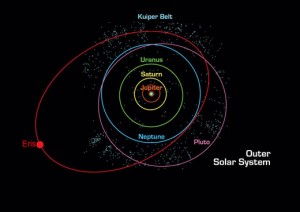Jan 16 2015
Trans-Neptunian Objects
 My mental map of our solar system has evolved over the years, as I have learned more about astronomy and as astronomers have learned more about our solar system. When I was younger that mental map ended with Pluto, the ninth and outermost planet of our system. I then learned that Pluto’s orbit takes it within the orbit of Neptune, and from 1979 to 1999 Neptune was actually the furthest planet.
My mental map of our solar system has evolved over the years, as I have learned more about astronomy and as astronomers have learned more about our solar system. When I was younger that mental map ended with Pluto, the ninth and outermost planet of our system. I then learned that Pluto’s orbit takes it within the orbit of Neptune, and from 1979 to 1999 Neptune was actually the furthest planet.
My mental map expanded greatly when I learned about the Kuiper belt and the Oort cloud (I can’t remember now which one I learned about first). The Kuiper belt is a doughnut shaped region of space beyond Neptune that contains many small icy worlds. The Oort cloud is a spherical shell farther out still that contains small chunks of dirty ice and is likely the source of many long period comets that sometimes fall into the inner solar system. Short period comets likely come from the Kuiper belt.
Pluto’s average distance from the sun is 39.5 AU (astronomical units – 1 AU is the average distance between the Earth and the Sun). So for much of my life that is how big the solar system was. The Kuiper belt ranges from 30 AU (the average distance of Neptune) to 55 AU. This expands the solar system a bit. However, the Oort cloud ranges from 5 thousand to 100 thousand AU.
The Kuiper belt is becoming an increasingly interesting place. When Pluto was “demoted” to a dwarf planet it became officially a trans-Neptunian object. Neptune is now the outermost planet, and Pluto must be content to be the king of the Kuiper belt objects. One of the other dwarf planets, Ceres, lives in the asteroid belt between Mars and Jupiter. The other three are all Kuiper belt objects: Makemake, Haumea, and Eris. With Pluto that makes 5 dwarf planets, four of which are “Plutoids” living in the Kuiper belt.
So that is my current mental map of the solar system – 8 planets, and asteroid belt between Mars and Jupiter, the Kuiper belt, 5 dwarf planets with one in the asteroid belt and the other 4 in the Kuiper belt, and then the distant Oort cloud like an outer shell of the solar system. There are also many moons. Did you know that Pluto has five moons?
However, I know that my map of the Kuiper belt is going to be significantly updated in the coming years. Right now that map includes a bunch of question marks floating out beyond Neptune. This region is known to contain many small rocky and icy worlds. There are almost certainly more dwarf planets to be discovered, perhaps even hundreds of them.
One big question is whether or not there are any full planets out there. Current theories of solar system formation suggest that large planets should not coalesce that far out, but our observation of other solar systems have found planet-forming clouds 100 AU or more from their parent stars. There may be superearths in our solar system waiting to be discovered.
Recently astronomers studying the orbits of trans-Neptunian objects found that their orbits are not as clean and tidy as theory predicts they should be. One possible explanation for this is trans-Neptunian planets. They feel there may be one or two planets in the Kuiper belt. Their survey was limited (only 13 objects) and so they need much more data to confirm their hypothesis. Of course, we have to actually find the planets to confirm their existence.
Another reason to suspect that my mental map will need updating is the New Horizons probe, which is just getting close enough to start studying Pluto. The probe’s primary mission is a flyby of Pluto, but it will also study the Kuiper belt. We can only wait to see what it will discover. I await with my mental map and virtual pen at the ready.






